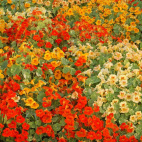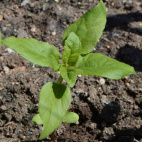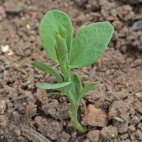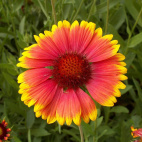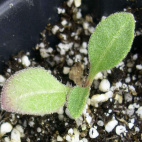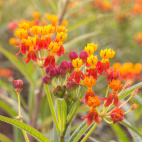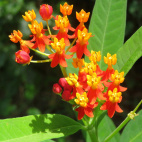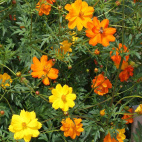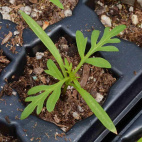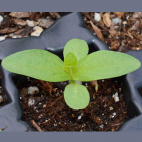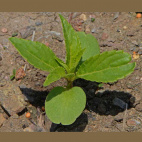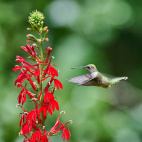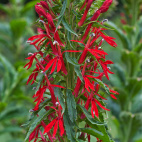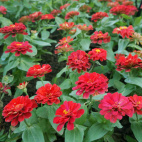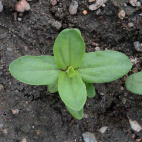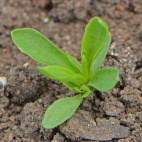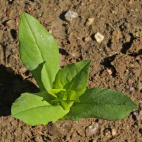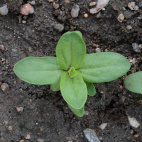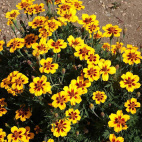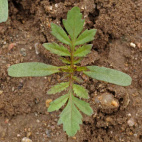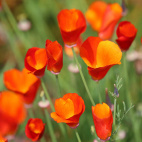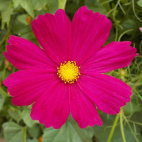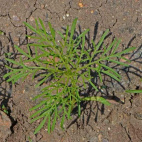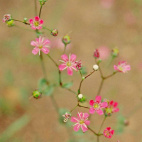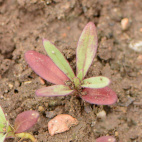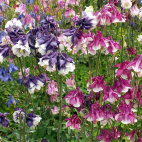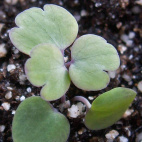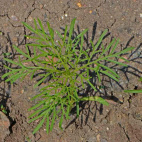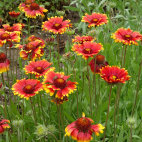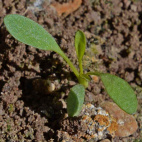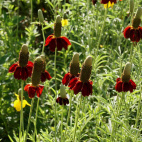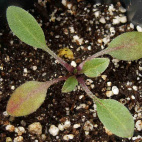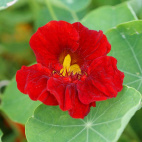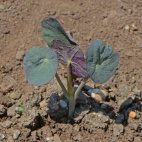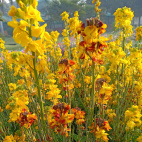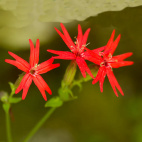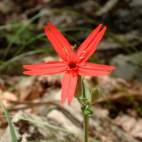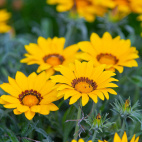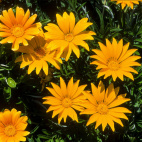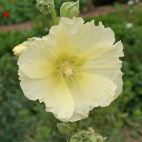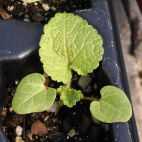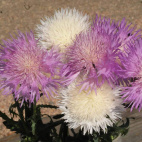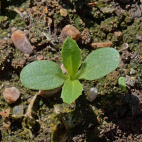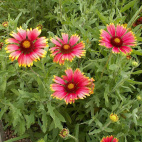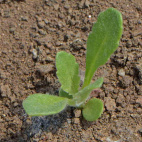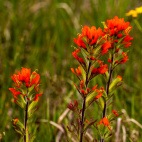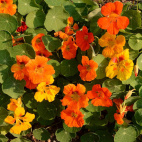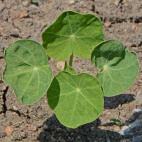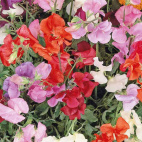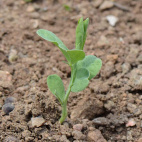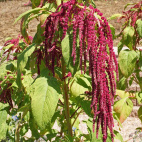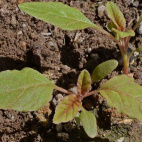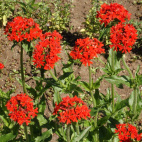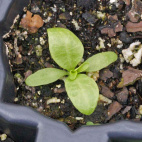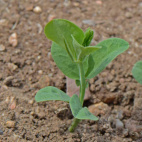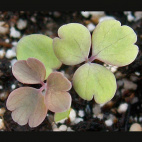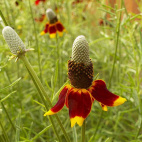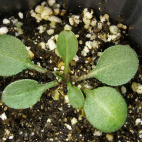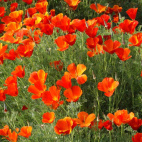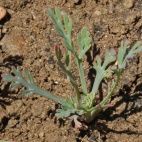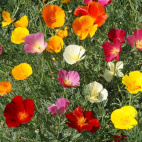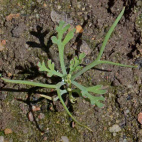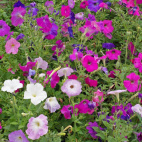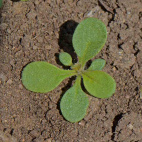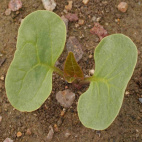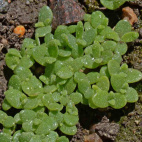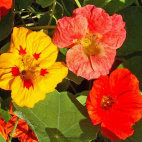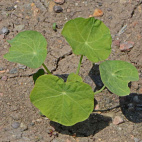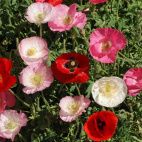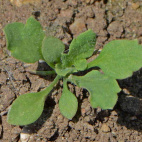Color
Availability
USDA Zone
Region
Type
Duration
Season
Germination
Soil
Sunlight
Height
Use
Narrow Your Search
Color
Availability
USDA Zone
Region
Type
Duration
Season
Germination
Soil
Sunlight
Height
Use
Wildflower Seeds - Northeast Region
-
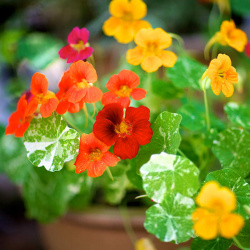 Alaska Nasturtium Seed Mix
Tropaeolum nanum
A dwarf variety, this mix comes in lovely shades of gold, orange, red, and yellow. This annual also has variegated leaves and is easy to grow, making it easy to have a beautiful flower bed with minimal effort.Quick View$3.48 Pkt - $6.84 / Oz
Alaska Nasturtium Seed Mix
Tropaeolum nanum
A dwarf variety, this mix comes in lovely shades of gold, orange, red, and yellow. This annual also has variegated leaves and is easy to grow, making it easy to have a beautiful flower bed with minimal effort.Quick View$3.48 Pkt - $6.84 / Oz -
 Autumn Beauty Sunflower Seeds
Helianthus annuus
The warm autumn tones of this sunflower mix are very popular and will add rustic beauty to your fall decor. This annual is relatively tall and will produce many different stripes and colors of sunflowers. The really neat thing about sunflowers is that their flower heads follow the movement of the sun throughout the day!Quick Viewx
Autumn Beauty Sunflower Seeds
Helianthus annuus
The warm autumn tones of this sunflower mix are very popular and will add rustic beauty to your fall decor. This annual is relatively tall and will produce many different stripes and colors of sunflowers. The really neat thing about sunflowers is that their flower heads follow the movement of the sun throughout the day!Quick ViewxAutumn Beauty Sunflower Seeds
Helianthus annuus
The warm autumn tones of this sunflower mix are very popular and will add rustic beauty to your fall decor. This annual is relatively tall and will produce many different stripes and colors of sunflowers. The really neat thing about sunflowers is that their flower heads follow the movement of the sun throughout the day!
$3.48 Pkt - $6.84 / Oz -
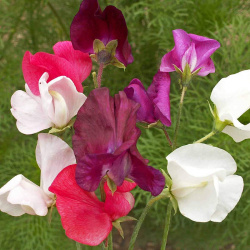 Bijou Sweet Pea Seed Mix
Lathyrus odoratus
This dwarf Sweet Pea variety produces masses of fragrant flowers on sturdy, bushy plants. Perfect for bouquets, this mix includes red, pink, purple, blue, and white. This annual is very easy to grow and is a must for those who love various aromas in their garden.Quick Viewx
Bijou Sweet Pea Seed Mix
Lathyrus odoratus
This dwarf Sweet Pea variety produces masses of fragrant flowers on sturdy, bushy plants. Perfect for bouquets, this mix includes red, pink, purple, blue, and white. This annual is very easy to grow and is a must for those who love various aromas in their garden.Quick ViewxBijou Sweet Pea Seed Mix
Lathyrus odoratus
This dwarf Sweet Pea variety produces masses of fragrant flowers on sturdy, bushy plants. Perfect for bouquets, this mix includes red, pink, purple, blue, and white. This annual is very easy to grow and is a must for those who love various aromas in their garden.
$3.75 Pkt - $9.35 / Oz -
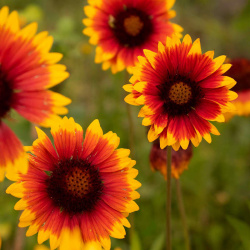 On Sale!
Blanket Flower Seeds
Gaillardia aristata
Reminiscent of an Indian blanket, this bi-colored variety comes in yellow, red, burgundy, and brown. Gaillardia Aristata is a native wildflower of the Northern Rockies, so it is better equipped to handle cold than its cousin, Indian Blanket. Buy these easy-to-grow Gaillardia Aristata seeds for color all season long.Quick Viewx
On Sale!
Blanket Flower Seeds
Gaillardia aristata
Reminiscent of an Indian blanket, this bi-colored variety comes in yellow, red, burgundy, and brown. Gaillardia Aristata is a native wildflower of the Northern Rockies, so it is better equipped to handle cold than its cousin, Indian Blanket. Buy these easy-to-grow Gaillardia Aristata seeds for color all season long.Quick ViewxBlanket Flower Seeds
Gaillardia aristata
Reminiscent of an Indian blanket, this bi-colored variety comes in yellow, red, burgundy, and brown. Gaillardia Aristata is a native wildflower of the Northern Rockies, so it is better equipped to handle cold than its cousin, Indian Blanket. Buy these easy-to-grow Gaillardia Aristata seeds for color all season long.
$3.48 Pkt - $7.59 / Oz -
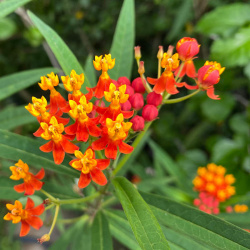 On Sale!
Blood Flower Seeds
Asclepias curassavica
Also known as tropical milkweed, these brilliant red and yellow blossoms explode with color in their first growing season. Although this species is a member of the Milkweed family, recent studies have shown that it actually may be detrimental to the Monarch Butterfly, especially in southern climates where the plants can survive year-round. The plants can harbor diseases that harm the Monarch, and disrupt their normal migratory patterns. Please only use this plant as an annual, and do not let it winter over!Quick Viewx
On Sale!
Blood Flower Seeds
Asclepias curassavica
Also known as tropical milkweed, these brilliant red and yellow blossoms explode with color in their first growing season. Although this species is a member of the Milkweed family, recent studies have shown that it actually may be detrimental to the Monarch Butterfly, especially in southern climates where the plants can survive year-round. The plants can harbor diseases that harm the Monarch, and disrupt their normal migratory patterns. Please only use this plant as an annual, and do not let it winter over!Quick ViewxBlood Flower Seeds
Asclepias curassavica
Also known as tropical milkweed, these brilliant red and yellow blossoms explode with color in their first growing season. Although this species is a member of the Milkweed family, recent studies have shown that it actually may be detrimental to the Monarch Butterfly, especially in southern climates where the plants can survive year-round. The plants can harbor diseases that harm the Monarch, and disrupt their normal migratory patterns. Please only use this plant as an annual, and do not let it winter over!
$3.48 Pkt - $14.49 / Oz -
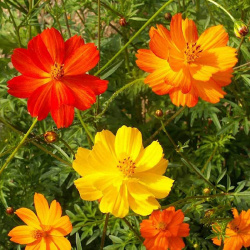 Bright Lights Sulphur Cosmos Seed Mix
Cosmos sulphureus
Light up the landscape with these cheerful red, orange, and yellow blossoms that are shorter than most Cosmos varieties. This easy-to-grow annual will reward the gardener who does not have much time to fuss with plants.Quick View$3.48 Pkt - $7.01 / Oz
Bright Lights Sulphur Cosmos Seed Mix
Cosmos sulphureus
Light up the landscape with these cheerful red, orange, and yellow blossoms that are shorter than most Cosmos varieties. This easy-to-grow annual will reward the gardener who does not have much time to fuss with plants.Quick View$3.48 Pkt - $7.01 / Oz -
 California Giants Zinnia Seed Mix
Zinnia elegans
These enormous zinnias come in a stunning mix of pink, purple, red, orange, white, and yellow. This easy-to-grow annual blooms all summer long, and will attract butterflies to your yard and garden.Quick View$3.48 Pkt - $7.59 / Oz
California Giants Zinnia Seed Mix
Zinnia elegans
These enormous zinnias come in a stunning mix of pink, purple, red, orange, white, and yellow. This easy-to-grow annual blooms all summer long, and will attract butterflies to your yard and garden.Quick View$3.48 Pkt - $7.59 / Oz -
 Camilia Flowered Balsam Seed Mix
Impatiens balsamina
A Victorian favorite, this beautiful heirloom annual is an excellent choice for containers or as a border plant. The large, double blossoms come in a mix of rose, white, scarlet, and violet.Quick View$3.48 Pkt - $7.65 / Oz
Camilia Flowered Balsam Seed Mix
Impatiens balsamina
A Victorian favorite, this beautiful heirloom annual is an excellent choice for containers or as a border plant. The large, double blossoms come in a mix of rose, white, scarlet, and violet.Quick View$3.48 Pkt - $7.65 / Oz -
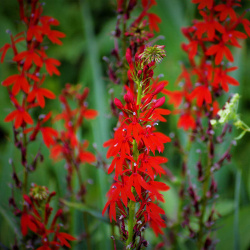 Cardinal Flower Seeds
Lobelia cardinalis
True to its name, this brilliant wildflower sports the scarlet hue of the cardinal. It has been called the reddest red in nature and flourishes in wet areas near ponds or streams. This flower is a native perennial wildflower that attracts hummingbirds and butterflies.Quick Viewx
Cardinal Flower Seeds
Lobelia cardinalis
True to its name, this brilliant wildflower sports the scarlet hue of the cardinal. It has been called the reddest red in nature and flourishes in wet areas near ponds or streams. This flower is a native perennial wildflower that attracts hummingbirds and butterflies.Quick ViewxCardinal Flower Seeds
Lobelia cardinalis
True to its name, this brilliant wildflower sports the scarlet hue of the cardinal. It has been called the reddest red in nature and flourishes in wet areas near ponds or streams. This flower is a native perennial wildflower that attracts hummingbirds and butterflies.
$3.75 Pkt - $80.00 / Oz -
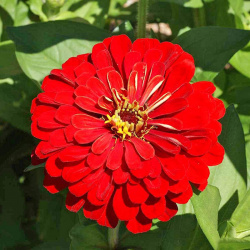 On Sale!
Cherry Queen Zinnia Seeds
Zinnia elegans
Robed in crimson, these stately beauties will not go unnoticed. Zinnias are easy to grow and will quickly reach blooming size, making them a fun project for children to grow.Quick View$3.48 Pkt - $7.92 / Oz
On Sale!
Cherry Queen Zinnia Seeds
Zinnia elegans
Robed in crimson, these stately beauties will not go unnoticed. Zinnias are easy to grow and will quickly reach blooming size, making them a fun project for children to grow.Quick View$3.48 Pkt - $7.92 / Oz -
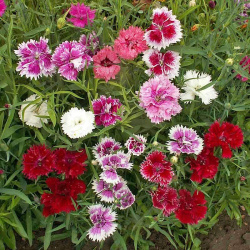 Chinese Pinks Seeds
Dianthus chinensis
Add a bit of exotic flair to the garden spot with these brilliant, fringed blossoms. This variety will flourish with little effort and will yield multitudes of exquisite little blooms.Quick Viewx
Chinese Pinks Seeds
Dianthus chinensis
Add a bit of exotic flair to the garden spot with these brilliant, fringed blossoms. This variety will flourish with little effort and will yield multitudes of exquisite little blooms.Quick ViewxChinese Pinks Seeds
Dianthus chinensis
Add a bit of exotic flair to the garden spot with these brilliant, fringed blossoms. This variety will flourish with little effort and will yield multitudes of exquisite little blooms.
$2.98 Pkt - $10.45 / Oz -
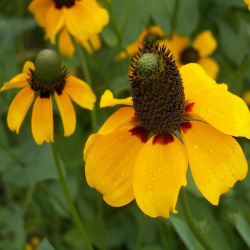 Clasping Coneflower Seeds
Rudbeckia amplexicaulis
Though similar to the Black-Eyed Susan, this bright wildflower is identified by its clasping coneflower leaves and a bit of red showing at the base of the yellow petals. This easy-to-grow annual requires little care and will grow in a wide variety of garden locations.Quick Viewx
Clasping Coneflower Seeds
Rudbeckia amplexicaulis
Though similar to the Black-Eyed Susan, this bright wildflower is identified by its clasping coneflower leaves and a bit of red showing at the base of the yellow petals. This easy-to-grow annual requires little care and will grow in a wide variety of garden locations.Quick ViewxClasping Coneflower Seeds
Rudbeckia amplexicaulis
Though similar to the Black-Eyed Susan, this bright wildflower is identified by its clasping coneflower leaves and a bit of red showing at the base of the yellow petals. This easy-to-grow annual requires little care and will grow in a wide variety of garden locations.
$2.98 Pkt - $7.27 / Oz -
 Dahlia Flowered Zinnia Seed Mix
Zinnia elegans
These bright flowers come in a splendid array of colors and are shaped like Dahlias. This easy-to-grow annual blooms all summer long, and catches the attention of wandering butterflies.Quick View$3.48 Pkt - $7.59 / Oz
Dahlia Flowered Zinnia Seed Mix
Zinnia elegans
These bright flowers come in a splendid array of colors and are shaped like Dahlias. This easy-to-grow annual blooms all summer long, and catches the attention of wandering butterflies.Quick View$3.48 Pkt - $7.59 / Oz -
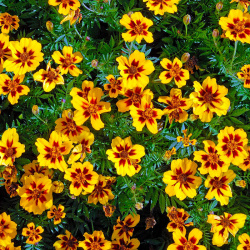 Dainty Marietta French Marigold Seeds
Tagetes patula
As dainty as they come, this petite French beauty blooms golden with dark red accents. This annual wildflower is a dwarf variety, so it works well for small gardens or container growing.Quick View$3.48 Pkt - $8.93 / Oz
Dainty Marietta French Marigold Seeds
Tagetes patula
As dainty as they come, this petite French beauty blooms golden with dark red accents. This annual wildflower is a dwarf variety, so it works well for small gardens or container growing.Quick View$3.48 Pkt - $8.93 / Oz -
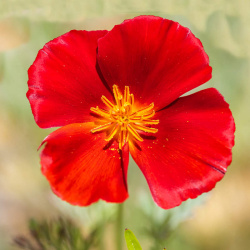 Out Of Stock
Dark Red California Poppy Seeds
Eschscholzia californica
This rare variety blooms in a rich, crimson hue. It is not always available, so check out Red Chief California Poppy if this variety is unavailable.Quick Viewx
Out Of Stock
Dark Red California Poppy Seeds
Eschscholzia californica
This rare variety blooms in a rich, crimson hue. It is not always available, so check out Red Chief California Poppy if this variety is unavailable.Quick ViewxDark Red California Poppy Seeds
Eschscholzia californica
This rare variety blooms in a rich, crimson hue. It is not always available, so check out Red Chief California Poppy if this variety is unavailable.
$3.48 Pkt - $8.93 / Oz -
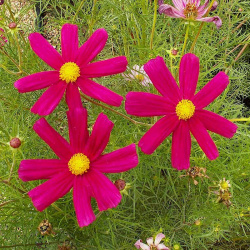 Dazzler Cosmos Seeds
Cosmos bipinnatus
These large, crimson flowers will simply dazzle the senses. If the color is too intense, it can be planted with other wildflowers to tone it down. This annual wildflower is very easy to grow and is an excellent choice for a beginning gardener.Quick View$3.48 Pkt - $7.52 / Oz
Dazzler Cosmos Seeds
Cosmos bipinnatus
These large, crimson flowers will simply dazzle the senses. If the color is too intense, it can be planted with other wildflowers to tone it down. This annual wildflower is very easy to grow and is an excellent choice for a beginning gardener.Quick View$3.48 Pkt - $7.52 / Oz -
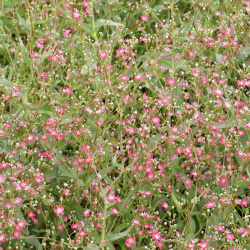 Deep Carmine Baby's Breath Seeds
Gypsophila elegans
Tiny crimson flowers, and feathery gray-green foliage gives a delicate, airy feel. This annual is perfect for floral arrangements and is very easy to grow in the home garden.Quick View$3.25 Pkt - $9.54 / Oz
Deep Carmine Baby's Breath Seeds
Gypsophila elegans
Tiny crimson flowers, and feathery gray-green foliage gives a delicate, airy feel. This annual is perfect for floral arrangements and is very easy to grow in the home garden.Quick View$3.25 Pkt - $9.54 / Oz -
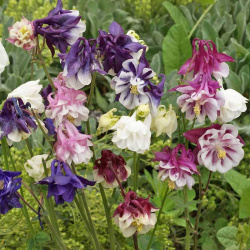 Dwarf Columbine Seed Mix
Aquilegia vulgaris
These delicate, nodding blossoms grow wild throughout much of northern Europe. This 16" dwarf variety produces a lovely mix of colors that will brighten any space!Quick View$3.48 Pkt - $12.65 / Oz
Dwarf Columbine Seed Mix
Aquilegia vulgaris
These delicate, nodding blossoms grow wild throughout much of northern Europe. This 16" dwarf variety produces a lovely mix of colors that will brighten any space!Quick View$3.48 Pkt - $12.65 / Oz -
 On Sale!
Dwarf Cosmos Seed Mix
Cosmos bipinnatus
These showy, colorful blossoms will have the neighbors talking. This easy-to-grow annual is shorter than most Cosmos varieties, so it fits well in smaller spaces. Cosmos is great for butterfly gardens and cut flower gardens alike.Quick View$3.48 Pkt - $7.92 / Oz
On Sale!
Dwarf Cosmos Seed Mix
Cosmos bipinnatus
These showy, colorful blossoms will have the neighbors talking. This easy-to-grow annual is shorter than most Cosmos varieties, so it fits well in smaller spaces. Cosmos is great for butterfly gardens and cut flower gardens alike.Quick View$3.48 Pkt - $7.92 / Oz -
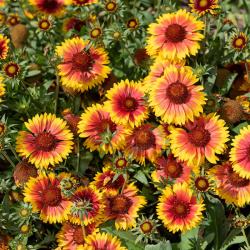 Out Of Stock
Dwarf Perennial Gaillardia Seeds
Gaillardia aristata
This showy golden flower is a petite version of the very popular Blanket Flower, and its short stature makes it ideal for small gardens or even container gardening. The easy-to-grow blooms provide color all season long.Quick Viewx
Out Of Stock
Dwarf Perennial Gaillardia Seeds
Gaillardia aristata
This showy golden flower is a petite version of the very popular Blanket Flower, and its short stature makes it ideal for small gardens or even container gardening. The easy-to-grow blooms provide color all season long.Quick ViewxDwarf Perennial Gaillardia Seeds
Gaillardia aristata
This showy golden flower is a petite version of the very popular Blanket Flower, and its short stature makes it ideal for small gardens or even container gardening. The easy-to-grow blooms provide color all season long.
$3.96 Pkt - $17.16 / Oz -
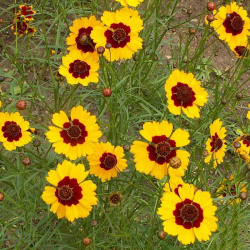 Dwarf Plains Coreopsis Seeds
Coreopsis tinctoria
This slender annual produces masses of yellow flowers with contrasting deep red centers. A popular choice of beginning gardeners because it is so easy to grow and produces a gratifying flower.Quick View$2.98 Pkt - $7.59 / Oz
Dwarf Plains Coreopsis Seeds
Coreopsis tinctoria
This slender annual produces masses of yellow flowers with contrasting deep red centers. A popular choice of beginning gardeners because it is so easy to grow and produces a gratifying flower.Quick View$2.98 Pkt - $7.59 / Oz -
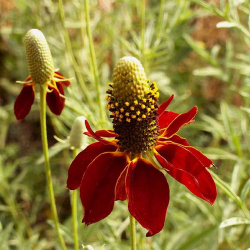 Out Of Stock
Dwarf Red Coneflower Seeds
Ratibida columnifera
This native dwarf wildflower bears a deep red flower beneath a long brown cone. This perennial does well in hot, dry areas, and is pretty easy to grow.Quick View$3.25 Pkt - $8.20 / Oz
Out Of Stock
Dwarf Red Coneflower Seeds
Ratibida columnifera
This native dwarf wildflower bears a deep red flower beneath a long brown cone. This perennial does well in hot, dry areas, and is pretty easy to grow.Quick View$3.25 Pkt - $8.20 / Oz -
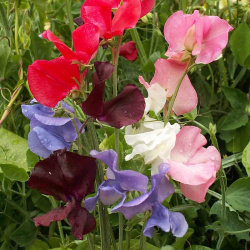 Early Multiflora Sweet Pea Seed Mix
Lathyrus odoratus
These annual vines produce an explosion of color and fragrance that will envelop you. This variety grows quite tall and includes blooms that are purple, fuchsia, red, pink, white, and blue. So easy to grow!Quick View$3.48 Pkt - $8.93 / Oz
Early Multiflora Sweet Pea Seed Mix
Lathyrus odoratus
These annual vines produce an explosion of color and fragrance that will envelop you. This variety grows quite tall and includes blooms that are purple, fuchsia, red, pink, white, and blue. So easy to grow!Quick View$3.48 Pkt - $8.93 / Oz -
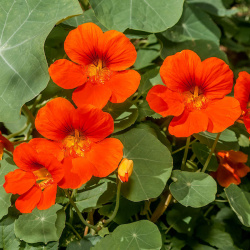 Empress of India Nasturtium Seeds
Tropaeolum nanum
A splendor to behold, these rich crimson flowers contrast with their blue-green foliage. This annual is compact and easy to grow, making it a great container plant.Quick View$3.48 Pkt - $6.84 / Oz
Empress of India Nasturtium Seeds
Tropaeolum nanum
A splendor to behold, these rich crimson flowers contrast with their blue-green foliage. This annual is compact and easy to grow, making it a great container plant.Quick View$3.48 Pkt - $6.84 / Oz -
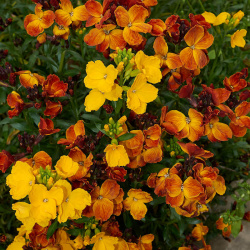 English Wallflower Seeds
Cheiranthus cheiri
This old English favorite pops up in castle ruins, roadsides, or any bit of rocky soil near the sea. The phlox-like orange blossoms also give off a pleasant fragrance.Quick View$2.98 Pkt - $8.46 / Oz
English Wallflower Seeds
Cheiranthus cheiri
This old English favorite pops up in castle ruins, roadsides, or any bit of rocky soil near the sea. The phlox-like orange blossoms also give off a pleasant fragrance.Quick View$2.98 Pkt - $8.46 / Oz -
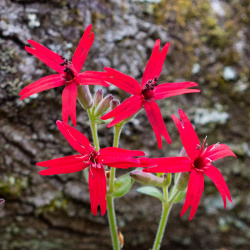 Out Of Stock
Fire Pink Seeds
Silene virginica
Best known for their fiery red blossoms, these rare flowers are stars of the show. This native perennial is fond of shady areas, but will also grow in sheltered areas with more sunshine.Quick View$3.96 Pkt - $320.00 / Oz
Out Of Stock
Fire Pink Seeds
Silene virginica
Best known for their fiery red blossoms, these rare flowers are stars of the show. This native perennial is fond of shady areas, but will also grow in sheltered areas with more sunshine.Quick View$3.96 Pkt - $320.00 / Oz -
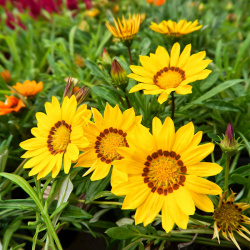 On Sale!
Gazania Seeds
Gazania splendens
These large, daisy-like flowers open with the sun and close with darkness. Coming from South Africa, they are naturally quite resistant to heat and drought. This multi-colored perennial makes an excellent addition to hillsides and wild areas in warmer climates, but can't handle the harsh winters of the north.Quick Viewx
On Sale!
Gazania Seeds
Gazania splendens
These large, daisy-like flowers open with the sun and close with darkness. Coming from South Africa, they are naturally quite resistant to heat and drought. This multi-colored perennial makes an excellent addition to hillsides and wild areas in warmer climates, but can't handle the harsh winters of the north.Quick ViewxGazania Seeds
Gazania splendens
These large, daisy-like flowers open with the sun and close with darkness. Coming from South Africa, they are naturally quite resistant to heat and drought. This multi-colored perennial makes an excellent addition to hillsides and wild areas in warmer climates, but can't handle the harsh winters of the north.
$3.96 Pkt - $26.00 / Oz -
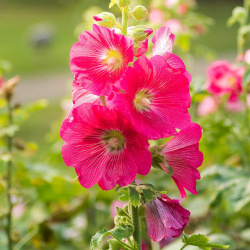 Hollyhock Seeds
Alcea rosea
This old-fashioned favorite is a popular pick for many flower enthusiasts. Many people plant the large, colorful blossoms in narrow spaces with a lot of headroom, such as along walls or fences. Usually blooms in the second year.Quick View$3.48 Pkt - $9.54 / Oz
Hollyhock Seeds
Alcea rosea
This old-fashioned favorite is a popular pick for many flower enthusiasts. Many people plant the large, colorful blossoms in narrow spaces with a lot of headroom, such as along walls or fences. Usually blooms in the second year.Quick View$3.48 Pkt - $9.54 / Oz -
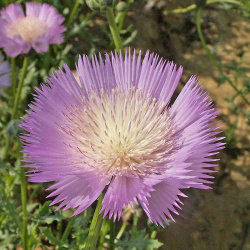 Imperialis Sweet Sultan Seed Mix
Amberboa moschata
These colorful, sweetly scented powder puffs are a cottage garden favorite. The easy-to-grow annual is excellent for cut flowers.Quick Viewx
Imperialis Sweet Sultan Seed Mix
Amberboa moschata
These colorful, sweetly scented powder puffs are a cottage garden favorite. The easy-to-grow annual is excellent for cut flowers.Quick ViewxImperialis Sweet Sultan Seed Mix
Amberboa moschata
These colorful, sweetly scented powder puffs are a cottage garden favorite. The easy-to-grow annual is excellent for cut flowers.
$3.48 Pkt - $8.70 / Oz -
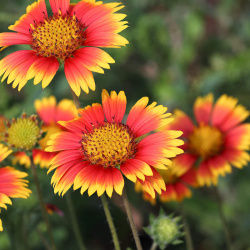 On Sale!
Indian Blanket Seeds
Gaillardia pulchella
Also known as Firewheel, this bi-colored variety comes in yellow, red, burgundy, and brown. It is a native wildflower of the Great Plains, and so is better equipped to handle heat and drought than other it's cousin, Blanket Flower. The easy-to-grow blooms provide color all season long.Quick Viewx
On Sale!
Indian Blanket Seeds
Gaillardia pulchella
Also known as Firewheel, this bi-colored variety comes in yellow, red, burgundy, and brown. It is a native wildflower of the Great Plains, and so is better equipped to handle heat and drought than other it's cousin, Blanket Flower. The easy-to-grow blooms provide color all season long.Quick ViewxIndian Blanket Seeds
Gaillardia pulchella
Also known as Firewheel, this bi-colored variety comes in yellow, red, burgundy, and brown. It is a native wildflower of the Great Plains, and so is better equipped to handle heat and drought than other it's cousin, Blanket Flower. The easy-to-grow blooms provide color all season long.
$3.48 Pkt - $7.92 / Oz -
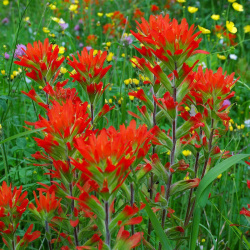 Indian Paintbrush Seeds
Castilleja coccinea
Paint the landscape with these brilliant red blooms! One of the most well-known and loved wildflowers, this variety grows across much of the western United States and can tolerate drought quite well.Quick View$3.96 Pkt - $300.00 / Oz
Indian Paintbrush Seeds
Castilleja coccinea
Paint the landscape with these brilliant red blooms! One of the most well-known and loved wildflowers, this variety grows across much of the western United States and can tolerate drought quite well.Quick View$3.96 Pkt - $300.00 / Oz -
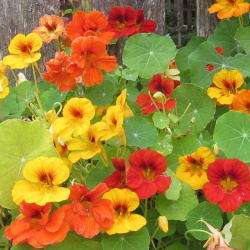 Jewel Nasturtium Seed Mix
Tropaeolum nanum
Like sparkling jewels, this beautiful mix of variegated gold, orange, red, and yellow will delight the eyes. This annual is easy to grow and can be easily grown by the gardening novice.Quick View$3.48 Pkt - $6.84 / Oz
Jewel Nasturtium Seed Mix
Tropaeolum nanum
Like sparkling jewels, this beautiful mix of variegated gold, orange, red, and yellow will delight the eyes. This annual is easy to grow and can be easily grown by the gardening novice.Quick View$3.48 Pkt - $6.84 / Oz -
 Knee High Sweet Pea Seed Mix
Lathyrus odoratus
Ideal for hanging baskets or window boxes, this bushy, semi-dwarf variety is just the right height. The sweet-scented blossoms show off in red, fuchsia, purple, and white. This annual is super easy to grow and will bloom in its first growing season.Quick View$3.48 Pkt - $9.54 / Oz
Knee High Sweet Pea Seed Mix
Lathyrus odoratus
Ideal for hanging baskets or window boxes, this bushy, semi-dwarf variety is just the right height. The sweet-scented blossoms show off in red, fuchsia, purple, and white. This annual is super easy to grow and will bloom in its first growing season.Quick View$3.48 Pkt - $9.54 / Oz -
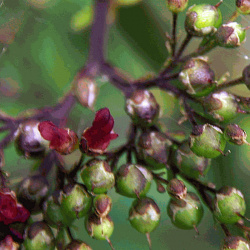 On Sale!
Late Figwort Seeds
Scrophularia marilandica
Though not usually noted for its appearance, this novel plant is rich in nectar. The small seed balls attract an abundance of butterflies, hummingbirds, and bees.Quick View$3.75 Pkt - $52.00 / Oz
On Sale!
Late Figwort Seeds
Scrophularia marilandica
Though not usually noted for its appearance, this novel plant is rich in nectar. The small seed balls attract an abundance of butterflies, hummingbirds, and bees.Quick View$3.75 Pkt - $52.00 / Oz -
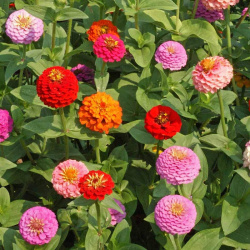 Lilliput Zinnia Seed Mix
Zinnia elegans
Shaped like little pom-poms, these bright flowers add pop and color to garden and bouquet. This flower is a semi-dwarf Zinnia and works well for planting into containers or small gardens. It is also an annual flower that is very easy to grow and does not need much fussing.Quick Viewx
Lilliput Zinnia Seed Mix
Zinnia elegans
Shaped like little pom-poms, these bright flowers add pop and color to garden and bouquet. This flower is a semi-dwarf Zinnia and works well for planting into containers or small gardens. It is also an annual flower that is very easy to grow and does not need much fussing.Quick ViewxLilliput Zinnia Seed Mix
Zinnia elegans
Shaped like little pom-poms, these bright flowers add pop and color to garden and bouquet. This flower is a semi-dwarf Zinnia and works well for planting into containers or small gardens. It is also an annual flower that is very easy to grow and does not need much fussing.
$3.48 Pkt - $7.59 / Oz -
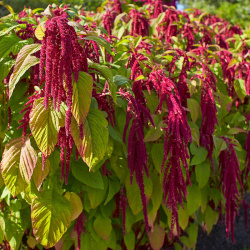 Love Lies Bleeding Seeds
Amaranthus caudatus
Once grown in Victorian English gardens, this unusual annual develops long, crimson tassels. In the language of flowers, it represents hopeless love. It is actually a pretty variety of grain from the amaranth family. Find out when to plant Love Lies Bleeding seeds by checking out our how to grow info.Quick Viewx
Love Lies Bleeding Seeds
Amaranthus caudatus
Once grown in Victorian English gardens, this unusual annual develops long, crimson tassels. In the language of flowers, it represents hopeless love. It is actually a pretty variety of grain from the amaranth family. Find out when to plant Love Lies Bleeding seeds by checking out our how to grow info.Quick ViewxLove Lies Bleeding Seeds
Amaranthus caudatus
Once grown in Victorian English gardens, this unusual annual develops long, crimson tassels. In the language of flowers, it represents hopeless love. It is actually a pretty variety of grain from the amaranth family. Find out when to plant Love Lies Bleeding seeds by checking out our how to grow info.
$2.98 Pkt - $7.01 / Oz -
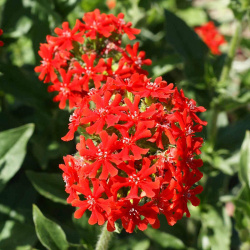 Maltese Cross Seeds
Lychnis chalcedonica
Growing in bright reddish-orange clusters, these striking flowers resemble a pointed star or cross. Hummingbirds and Swallowtail butterflies are attracted to the perennial blooms, which can easily be grown in most flower gardens.Quick View$2.98 Pkt - $9.88 / Oz
Maltese Cross Seeds
Lychnis chalcedonica
Growing in bright reddish-orange clusters, these striking flowers resemble a pointed star or cross. Hummingbirds and Swallowtail butterflies are attracted to the perennial blooms, which can easily be grown in most flower gardens.Quick View$2.98 Pkt - $9.88 / Oz -
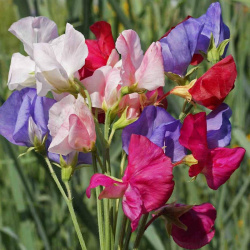 Mammoth Sweet Pea Seed Mix
Lathyrus odoratus
These large, ruffled blooms are sure to impress with lovely shades of pink, red, blue, lilac, and white. These heat-resistant vines flower well into the summer, filling every corner of the garden with their sweet perfumes. This flower is an easy to grow annual that will grow in almost any garden spot.Quick Viewx
Mammoth Sweet Pea Seed Mix
Lathyrus odoratus
These large, ruffled blooms are sure to impress with lovely shades of pink, red, blue, lilac, and white. These heat-resistant vines flower well into the summer, filling every corner of the garden with their sweet perfumes. This flower is an easy to grow annual that will grow in almost any garden spot.Quick ViewxMammoth Sweet Pea Seed Mix
Lathyrus odoratus
These large, ruffled blooms are sure to impress with lovely shades of pink, red, blue, lilac, and white. These heat-resistant vines flower well into the summer, filling every corner of the garden with their sweet perfumes. This flower is an easy to grow annual that will grow in almost any garden spot.
$3.48 Pkt - $9.71 / Oz -
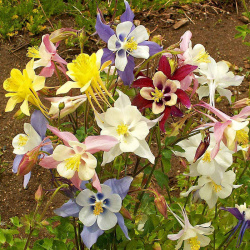 McKana Giants Columbine Seed Mix
Aquilegia caerulea
Developed explicitly for its large colorful blooms, this AAS Award winner first became available in the 1950s. A striking choice for any gardener who loves the distinctive columbine shaped flowers.Quick View$3.48 Pkt - $20.16 / Oz
McKana Giants Columbine Seed Mix
Aquilegia caerulea
Developed explicitly for its large colorful blooms, this AAS Award winner first became available in the 1950s. A striking choice for any gardener who loves the distinctive columbine shaped flowers.Quick View$3.48 Pkt - $20.16 / Oz -
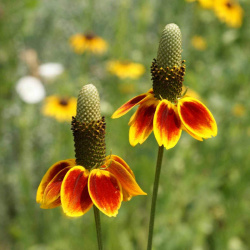 On Sale!
Mexican Hat Seeds
Ratibida columnifera pulcherrima
Aptly named, this popular Ratibida Columnifera Pulcherrima wildflower sports bright red and yellow petals beneath the tall center cone. This perennial is a native of the Great Plains, and so does well in hot, dry conditions.Quick View$2.98 Pkt - $7.92 / Oz
On Sale!
Mexican Hat Seeds
Ratibida columnifera pulcherrima
Aptly named, this popular Ratibida Columnifera Pulcherrima wildflower sports bright red and yellow petals beneath the tall center cone. This perennial is a native of the Great Plains, and so does well in hot, dry conditions.Quick View$2.98 Pkt - $7.92 / Oz -
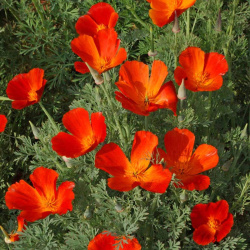 Mikado California Poppy Seeds
Eschscholzia californica
These brilliant orange petals with scarlet reverse, shimmer with rare beauty. They are the same height and form as the common Orange California Poppy, but fired up with some extra heat and color! Adds some zing to an old favorite, and it is straightforward to grow.Quick Viewx
Mikado California Poppy Seeds
Eschscholzia californica
These brilliant orange petals with scarlet reverse, shimmer with rare beauty. They are the same height and form as the common Orange California Poppy, but fired up with some extra heat and color! Adds some zing to an old favorite, and it is straightforward to grow.Quick ViewxMikado California Poppy Seeds
Eschscholzia californica
These brilliant orange petals with scarlet reverse, shimmer with rare beauty. They are the same height and form as the common Orange California Poppy, but fired up with some extra heat and color! Adds some zing to an old favorite, and it is straightforward to grow.
$2.98 Pkt - $10.04 / Oz -
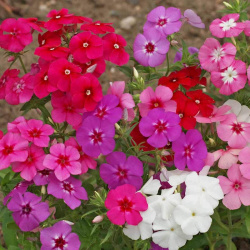 On Sale!
Annual Phlox Seed Mix
Phlox drummondii
Bearing clusters of lovely, fragrant flowers, this popular mix blooms in pink, red, rose, purple, and white. This mix is most often planted en masse so that the variegated colors can be more fully seen. This annual is very easy to grow and will attract a variety of pollinators to your garden.Quick Viewx
On Sale!
Annual Phlox Seed Mix
Phlox drummondii
Bearing clusters of lovely, fragrant flowers, this popular mix blooms in pink, red, rose, purple, and white. This mix is most often planted en masse so that the variegated colors can be more fully seen. This annual is very easy to grow and will attract a variety of pollinators to your garden.Quick ViewxAnnual Phlox Seed Mix
Phlox drummondii
Bearing clusters of lovely, fragrant flowers, this popular mix blooms in pink, red, rose, purple, and white. This mix is most often planted en masse so that the variegated colors can be more fully seen. This annual is very easy to grow and will attract a variety of pollinators to your garden.
$3.25 Pkt - $10.04 / Oz -
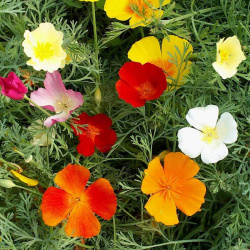 California Poppy Seed Mix
Eschscholzia californica
Can't decide which color of California Poppy seeds to buy? Experience a dazzling array of different colors with a carpet of this California Poppy mix. This mix is very easy to grow and is great for beginning gardeners.Quick View$2.98 Pkt - $8.46 / Oz
California Poppy Seed Mix
Eschscholzia californica
Can't decide which color of California Poppy seeds to buy? Experience a dazzling array of different colors with a carpet of this California Poppy mix. This mix is very easy to grow and is great for beginning gardeners.Quick View$2.98 Pkt - $8.46 / Oz -
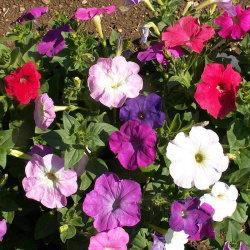 Dwarf Petunia Seed Mix
Petunia nana compacta
Bring back a garden favorite from the 1950s with this bright multicolored mix. The sturdy and compact growth of this annual is perfect for mass planting, hanging baskets, or container gardening.Quick View$3.48 Pkt - $17.72 / Oz
Dwarf Petunia Seed Mix
Petunia nana compacta
Bring back a garden favorite from the 1950s with this bright multicolored mix. The sturdy and compact growth of this annual is perfect for mass planting, hanging baskets, or container gardening.Quick View$3.48 Pkt - $17.72 / Oz -
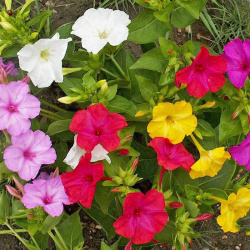 Four O'clock Seed Mix
Mirabilis jalapa
This flower has a habit of opening in the late afternoon, an unusual feature that is caused by changes in light and temperature. This garden favorite produces fragrant blossoms in brilliant pink, rose, red, white, and yellow.Quick View$3.48 Pkt - $5.96 / Oz
Four O'clock Seed Mix
Mirabilis jalapa
This flower has a habit of opening in the late afternoon, an unusual feature that is caused by changes in light and temperature. This garden favorite produces fragrant blossoms in brilliant pink, rose, red, white, and yellow.Quick View$3.48 Pkt - $5.96 / Oz -
 On Sale!
Ice Plant Seed Mix
Mesembryanthemem criniflorum
This plant's unusual name was most likely inspired by the crystal-like texture of its foliage. This vibrant annual also produces masses of daisy-like flowers in red, orange, yellow, pink, white, or purple.Quick View$2.98 Pkt - $8.20 / Oz
On Sale!
Ice Plant Seed Mix
Mesembryanthemem criniflorum
This plant's unusual name was most likely inspired by the crystal-like texture of its foliage. This vibrant annual also produces masses of daisy-like flowers in red, orange, yellow, pink, white, or purple.Quick View$2.98 Pkt - $8.20 / Oz -
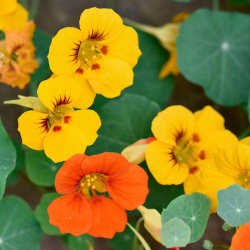 On Sale!
Tall Nasturtium Seed Mix
Tropaeolum majus
Scatter these seeds anywhere for a gorgeous mix of large gold, orange, red, and yellow blossoms. This popular annual is tall for the nasturtium family, so it will need more room than the dwarf varieties. This flower is easy to grow and is a good wildflower for the beginning gardener.Quick Viewx
On Sale!
Tall Nasturtium Seed Mix
Tropaeolum majus
Scatter these seeds anywhere for a gorgeous mix of large gold, orange, red, and yellow blossoms. This popular annual is tall for the nasturtium family, so it will need more room than the dwarf varieties. This flower is easy to grow and is a good wildflower for the beginning gardener.Quick ViewxTall Nasturtium Seed Mix
Tropaeolum majus
Scatter these seeds anywhere for a gorgeous mix of large gold, orange, red, and yellow blossoms. This popular annual is tall for the nasturtium family, so it will need more room than the dwarf varieties. This flower is easy to grow and is a good wildflower for the beginning gardener.
$3.48 Pkt - $5.96 / Oz -
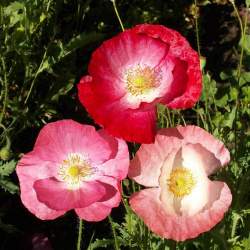 Single Poppy Seed Mix
Papaver rhoeas
Create a shimmering wave of color with this bright mix, which contains the super-popular Red Poppy, along with pink and white variations. This annual often self-sows and is highly attractive to bees, butterflies, and birds.Quick View$2.98 Pkt - $7.59 / Oz
Single Poppy Seed Mix
Papaver rhoeas
Create a shimmering wave of color with this bright mix, which contains the super-popular Red Poppy, along with pink and white variations. This annual often self-sows and is highly attractive to bees, butterflies, and birds.Quick View$2.98 Pkt - $7.59 / Oz













